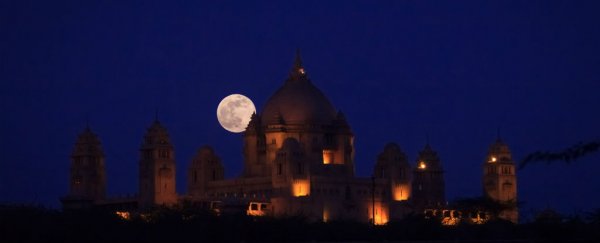Last month, the world got to experience a record-breaking supermoon, when the Moon reached its closest point to Earth since January 1948. It was the closest full moon so far in the 21st century, and it's not going to get any closer until 25 November 2034.
And while that supermoon was particularly close, we've actually got one more to tide us over before the end of the year, and it just so happens to coincide with one of the best meteor showers of the year.
If that fact is setting off some alarm bells, you're obviously a seasoned skywatcher, because yes - a bright, full moon doesn't usually mix well with an awesome meteor shower, on account of all the extra moonlight dimming the impact of the meteors.
But the Geminid meteor shower is no ordinary meteor shower.
The meteors tend to be particularly bright, prolific, and reliable, and they can leave long persistent trails through the night sky.
If can get out under the stars during its peak, the Geminids is expected to deliver an impressive 120 meteors per hour.
"It's usually the best meteor shower of the year," NASA meteor expert Bill Cooke told Space.com.
This year, the peak will hit on the night of December 13, when you should still see the brightest meteors of the bunch, despite the Moon's supercharged reflection.
While Northern Hemisphere viewers can start spotting meteors just after sunset - which makes this shower a great one for kids with early bedtimes to experience - those in the Southern Hemisphere need to plan for some time after midnight.
The peak viewing time, wherever you are in the world, is expected to be around 2am on December 13.
"That's because the constellation Gemini - radiant point of the shower - will reach its highest point for the night around 2am (your local time)," Bruce McClure explains for EarthSky.org.
"As a general rule, the higher the constellation Gemini climbs into your sky, the more Geminid meteors you're likely to see."
McClure recommends giving yourself an hour or so to spot meteors, because it'll take your eyes 20 minutes to adjust to the darkness, and then since you're fighting with the moonlight, you're going to want to make sure you stick around long enough to catch the brightest meteors.
You should be able to see meteors on any night from December 12 to 15, and the good news is you don't need any special equipment to see this event - just a dark setting away from the city lights, and a good deck chair or picnic rug.
And of course, this year is special, because you've got the last supermoon of the year to keep you company too.
The supermoon is caused by the Sun, Moon, and Earth lining up as the Moon orbits Earth. That's known as syzygy.
"When this Earth-Moon-Sun system occurs with the perigee side of the Moon facing us, and the Moon happens to be on the opposite side of Earth from the Sun, we get what's called a perigee-syzygy.
That causes the Moon to appear much bigger and brighter in our sky than usual, and it's referred to as a supermoon - or more technically, a perigee moon."
Last month's supermoon was record-breaking in its closeness, and the fact that it was perfectly timed with a full moon, but supermoons themselves aren't all that uncommon. The next one is 3 December 2017, though, so you've got almost a year before you can see one again.
According to Space.com, the supermoon will reach peak fullness at 7:05pm EST (0005 GMT) on December 14 for those of you in the Northern Hemisphere, but it will appear full on the night before and after its peak, hence the meteor shower mess-up.
In the Southern Hemisphere, it will reach peak fullness at 11:05am AEDT on December 14.
And just as an extra extra treat, not only will you get the Geminid meteor shower and supermoon, you also get a planet.
"Quite by coincidence, the dazzling planet Jupiter will rise in the east at about the same time that the Geminid radiant climbs highest up for the night: around 2am," says McClure at EarthSky.org.
"So count upon Jupiter, the sole visible planet in the December 2016 morning sky, to keep you good company from about 2am until dawn!"
Happy skywatching, guys!
